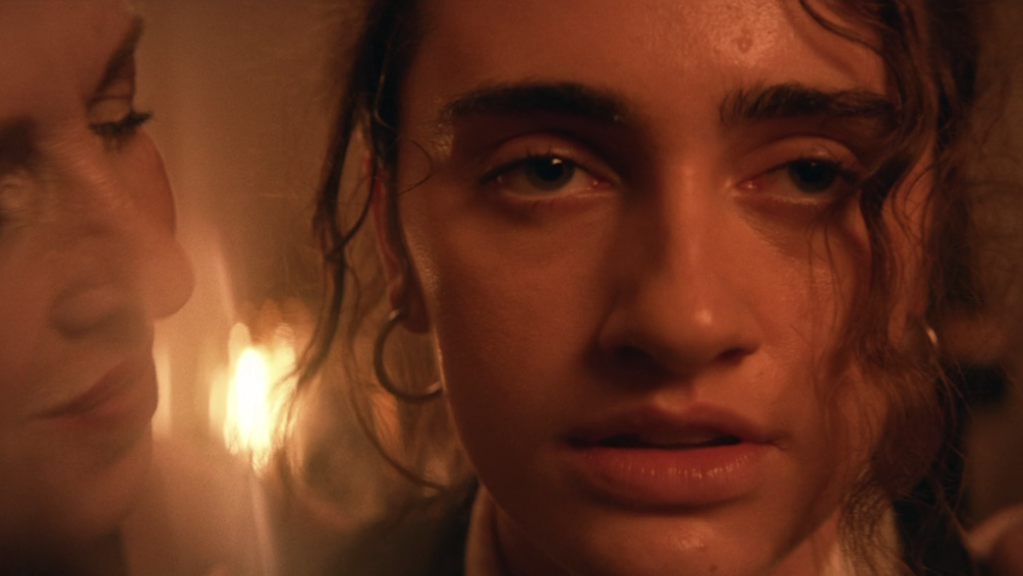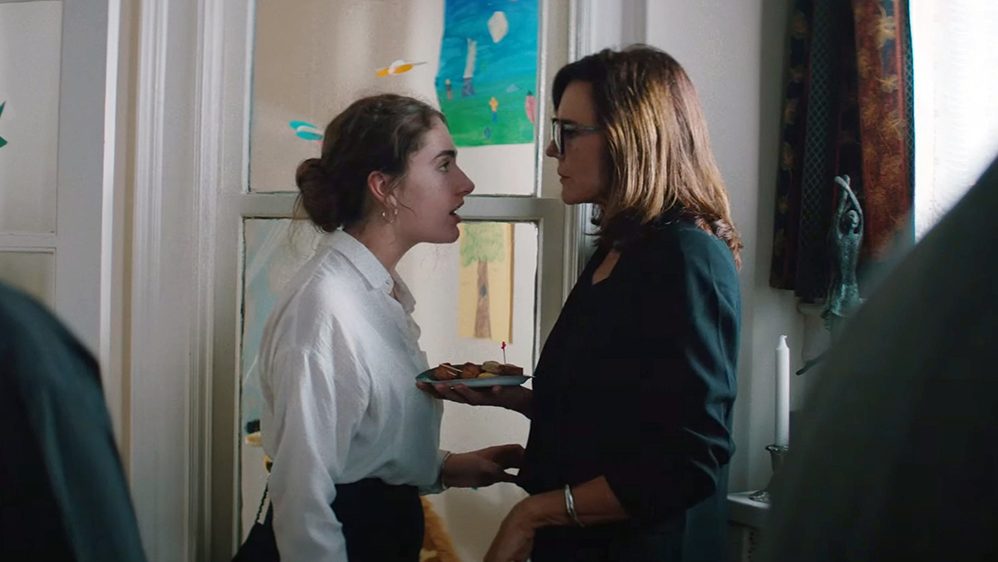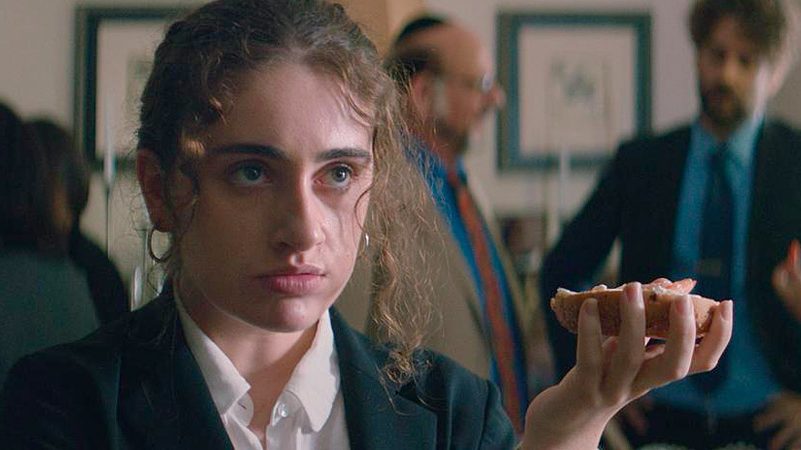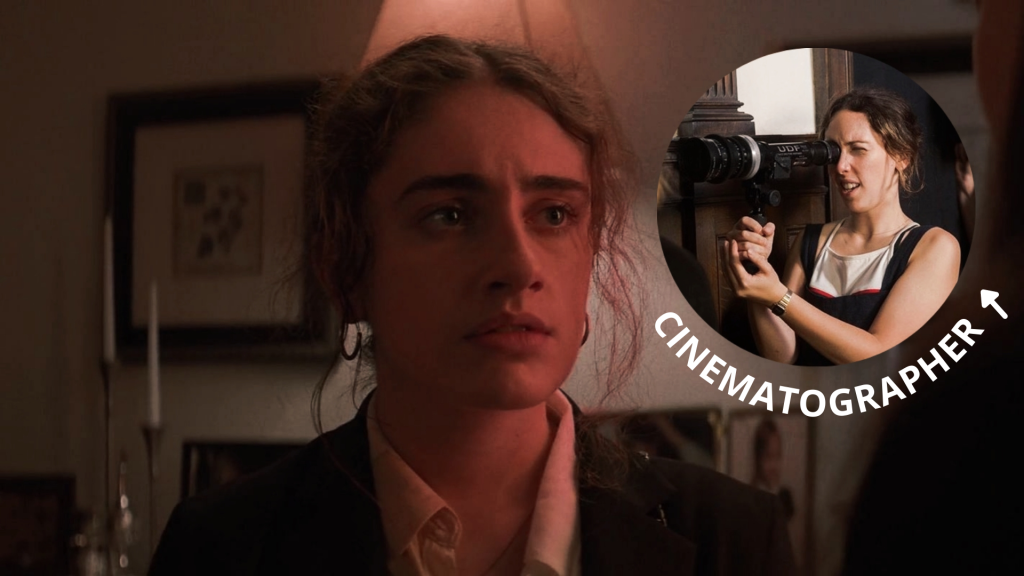Written by Malin Evita
This transcript has been edited and condensed. Listen to “Explore Cinematography with Shiva Baby DoP Maria Rusche,” available on all major podcast platforms for the full interview. Watch Shiva Baby on Amazon Video Prime with a MUBI membership.
Shiva Baby is the directorial feature debut of writer-director Emma Seligman. It stars Rachel Sennott as Danielle—a young bisexual college student—and her survival of a house of horror. She is obligated to attend a shiva, a Jewish funeral tradition, where her sugar daddy and ex-girlfriend collude, all midst the chaos of family and community members who know no boundaries, persistently poke her with questions about her future career and eating habits.
The story is gripping and oddly comedic, exploring themes of young adulthood and the nuances of sexuality and sexual empowerment. From the snarky dialogue to the hazy fog of social anxiety, it also provokes deep resonance for anyone who’s watching. This is underlined through its cinematography which is unwavering in its aim to make you stand in Danielle’s shoes. To explore the composition of this creation, Shiva Baby cinematographer Maria Rusche came on the Making It: Women in Film podcast to talk all about her creative process and career journey.
“Rachel Sennott, who plays Danielle, the lead, used to write these sketches when she was at NYU. She was, I think, around Emma’s year – maybe one year younger. And a friend of mine would direct these sketches for Rachel, and I would shoot them! They were all so funny, like super… all over the place. Rachel Sennott is a prolific artist; I have to say. She is super motivated and great at kind of putting out content,” Maria says, “So I had worked with Rachel a few times, and she recommended me to Emma [Seligman, director] for the feature.”
In late 2018, Emma approached her with the project. “And they, like many low-budget independent features, were still looking for financing, and you kind of have to create this moving train, even though you are building the train as you go.” But in 2019, the pieces had started to come together, and in August, they started shooting.
The feature is based on a short film of the same name, which Maria used as her initial reference point. “I understood from the short that a lot of the comedy comes from the characters being put in this kind of serious situation. So if we were kind of over the top with shooting it like a comedy, it wouldn’t have the same weight to it.” After getting together with the director, the two then looked through their references, which is usually a mix of photo dumps and films.

The goal of reference sorting is to find their tone, to figure out what story they want to tell, how it compares to other similar or not so similar stories, and from that, build a visual library of what they want their movie to look like. After that, you get into location scouting and shot listing. “A huge part of that is also the production designer; they come in as we start to talk about locations, and they are really crucial for then obviously what we are seeing,” Maria adds. For this feature, Cheyenne Ford was the production designer in charge of the consequential setting of the house the shiva is hosted in. Learn more about what production designers do here.
For Shiva Baby, one movie, in particular, stood out in the well of references. Maria explained it as such when they were putting together the atmosphere they desired to frame:
“Our overall plans and ideas revolved a lot around Danielle’s perspective within this kind of nightmare-ish scenario. And we really looked a lot at the movie Black Swan because of how you really stay within Natalie Portman’s character’s perspective. The way that they do that is a lot of tight, following shots—or leading shots—and obviously [Black Swan] is more specifically a psychological horror movie, but I think that felt true in a lot of ways to what we were trying to capture with [Rachel’s] performance. So we talked a lot about, kind of, how to build the experience of her perspective over the course of the film and how to- we didn’t want it to be one-note, so we are constantly tight, for example. But how could we increase the tension as we go on so that you understand how she can get to this breaking point, and so that you understand that it feels like the place is crashing down around her and suffocating her.”

And it wasn’t just challenging for Danielle’s character. Filming in one house that is stuffed with people didn’t present the most straightforward shoot. “It was hot. It was August. Everyone was wearing suits, and it was so hot. And it was very much, thinking back now, a pre-covid set. But I think it was a huge challenge for us to shot list and schedule the movie based on when we had certain cast [members] because we really lucked out with an incredible cast. But the flip side of having such seasoned actors was [that] we were a little at the whim of what their schedule was, so I think we only had two days with the entire cast. So a lot of times, we would shoot a part of one scene where we would see Molly Gordon [who plays Maya], for example, and then we would have to shoot the rest of the scene on a different day when we had the other characters there,” she says.
To sustain continuity, director Emma Seligman made a LEGO version of the set, which they used to very specifically block out where each person had been standing while they filmed them and where they were at every single point during the shiva. “You think you are saving a lot by writing a film that is in one location, you know you save a lot of the budget maybe, but it does turn out that [the movie] was nearly continuous in timeline and so it created a different problem,” she explains. The shooting lasted for seventeen days—sixteen within the house and one for the opening sex scene in the sugar daddy apartment.

One of the other ways they would keep track of the scenes was through warmth. “I have a lot of documents that show how the lighting changes over certain scenes, and it is broken down like scene 36 and 37 is this level of warmth—because we designed it to get warmer over the course of the shiva. It kind of helped increase that anxiety, and that way, if we were shooting scenes 36 and 41, we kind of knew what level of warmth we were supposed to be at.”
This is a movie that is completed by the collaboration between cinematic art forms. From the excellent writing and directing to the chilling score that feels as if it was ripped from a classic horror film (props to composer Ariel Marx), and of course, the suffocating cinematography. Each adds another layer to the other, creating a deeply immersive canvas for Rachel Sennott to play her heart out. Maria Rusche captured the anxiety of being forced to attend social events with such precision it feels like ants are crawling under your skin while you’re watching, and you just can’t get them to stop.
“There were a few [shots] that were really satisfying. One of them was when Danielle is stuck between her mom and the mom’s friend, and they are kind of, like, pinching her cheeks,” she says, “We slowly push into this frame that is mostly just Rachel’s face, but you see the hands coming in and just the edges of the older women’s mouths. And that… Just kind of seeing their hands and their mouths is exactly, to me, how that feels, to be in that position. It is definitely rewarding to have moments like that where you’re like yes, that composition or camera movement or lighting in some way evokes the feeling for you that supports where the story is at that moment.”

Learn and listen to our full conversation with Maria Rusche for an even further deep dive into the composition and execution of Shiva Baby—not to mention her own career journey from being an aspiring editor to NYU student, to set electrician, and now freelance director of photography. Episode 45 is available now on Spotify, Apple, Google, or wherever you get your podcasts!
Written by Malin Evita
Evita is the host and producer of the podcast, Instagram curator, and a writer focused on script, cultural commentary, and film analysis. She is a Vocal grand prize winner and currently studies Professional Writing at college. Through storytelling, she aims to amplify empathy and human connectivity.
Website: malinevita.com | IG: @malinevita


One response to “Cinematographer Maria Rusche On How She Captured the Intimate and Claustrophobic Atmosphere of “Shiva Baby””
[…] Panic Attack, Shiva Baby […]
LikeLike